Panthera
Senast uppdaterad den 5 februari 2024, 83 kommentarer
Bilder | Specifikationer | Mer om | Bakgrund och historia
Ritningssats, Panthera - 1 500 SEK
Beställ
Snabbtitt på prestanda

manöverbarhet |

kursstabilitet |

marschfart |

toppfart |

initialstabilitet |

slutstabilitet |

lastkapacitet |
Rekommenderad utrustning: justerbar skädda roder skott/luckor
Panthera är en ny hybrid-kajak – enkelt uttryckt en surfski med kajakdäck. Men riktigt så enkelt är det såklart inte. Även om skrovformen i grunden är en Spindrift finns en inte obetydligt influens från Njord. Jag förväntar mig därför att kajaken är aningen lugnare än en renodlad surfski, men att den ändå är kontrollerbar om man skulle drabbas av en akut lust att diagonalsurfa i grov sjögång. Jag väntar mig också att man på surfskivis kan hålla en högre fart i medsjö just genom surfegenskaperna.
I grunden ligger Panthera så nära surfskiidealet att ett roder är nödvändigt för att dra full nytta av potentialen (mer om skillnaden här). Ett underliggande surfskiroder är naturligtvis bäst, för precisionen i styrningen, men med lite havskajak i konceptet fungerar det bra även med att akterhängt roder – gärna då med något av de lite större bladen (eller ett integralroder). Med långfärdslast ligger kajaken lite djupare i vattnet och därmed med lite mer kursstabilitet, vilket ger en mer avslappnad paddling på långa dygnsdistanser.
John Abercrombie, som byggde Panthera nummer 1 (se nedan) hade följande att meddela på kajakforum.com efter en mycket kort testrunda en midvinterdag i sydvästra Canada.
I thought I'd share my first paddling impressions of my new boat (Bjorn Thomasson Panthera) from a very short outing this afternoon.
I like it! ;-)
Hopping in the boat, the initial feel is a lot like Frej - it feels compact and 'ready to go' but not at all 'twitchy' or unstable.
Secondary stability is excellent- I can set it up on edge very easily, and it stays there. It rolls easily - and I'm not an accomplished roller, at all. The low back deck (like Frej) makes sweep rolls easy.
It feels quick - with the footboard it's easy to put my knees and feet in the middle of the boat and get good rotation and drive. I'll need to put the GPS on it for a longer outing to get some data on the speed.
Maneuverability:
With the rudder down, it goes where it's told with no fuss.
Rudder up - it's quite agile even when not edged (flat). Responds well to sweep strokes which skid the stern around easily, and bow rudder strokes work well. When set on edge, the steering strokes work even better (as you'd expect). Hanging draw stroke works well.
I'll let you know how it does in a breeze and waves, and also with some more weight in the boat, as the season progresses.
John Abercrombie
Arto Nikula i Finland har många bra och instruktiva bilder från sitt Panthera-bygge.
Peter Träisk har en intressant roderkonstruktion på sin Panthera
Panthera L
Jag fick en förfrågan från en storvuxen paddlare från det stora landet i väster om en lite rymligare Panthera, vilket ledde till en expanderad version: en cm bredare och ett par cm högre men med samma längd. Den lastar 15 kg mer och har 20 liter mer volym. Är du stor (>190 cm/95kg), tycker det där med att resa lätt är fånigt eller har andra goda skäl kan du notera i kommentarsfältet vid beställningen att du vill ha en "L". Men tänk på att om du väger för lite för den större versionen, flyter kajaken för högt och du förlorar stabilitet, både genom smalare vattenlinje och högre tyngdpunkt, samtidigt som kajaken blir svårare att hantera när det blåser. Lagom är faktiskt bäst, även när det gäller kajaker.
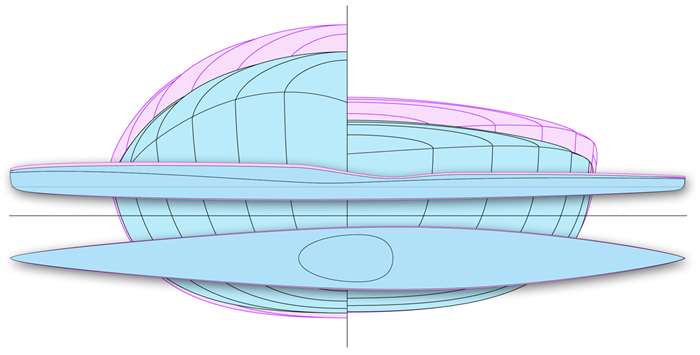
Yttermåtten för Panthera (ljusblå) och Panthera L (ljuslila)
Panthera Stitch&glue
Om du tvekar inför ett stripbygge, finns det ett enklare sätt att få nästan samma kajak. Jag har tillsammans med Petruskajak i Tranås tagit fram en plywoodversion av Panthera. Den finns att bygga hos Petruskajak i hans numera välkända 8-dagarskurser, men kan också köpas som byggsats.
Stitch-and-glue-konceptet innebär att färdiga CNC-frästa plywoodpaneler "sys" ihop till skrov och däck, varefter skarvarna stabiliseras på insidan med glasfiberremsor i epoxy, och utsidan lamineras med glasfiber. Resultatet blir en lätt och stark kajak på grovt räknat halva tiden mot ett stripbygge – eller på en fjärdedel av tiden för den som har ambitioner som inbegriper dekorativ strippning med olika träslag ;-)
S&G Panthera är en lättbyggd version Panthera. Metoden kräver enkelkrökta ytor, vilket innebär plana ytor och skarpa slag. Det betyder i praktiken en aning fartförlust genom turbulens och en aning mindre innervolym. Skillnader i egenskaper är i praktiken knappt märkbara, och får vägas mot det enklare bygget.
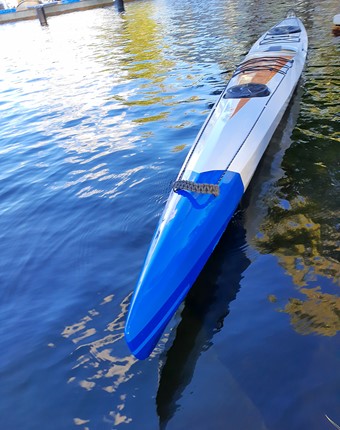
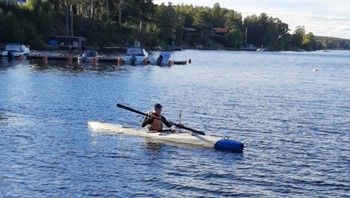
Specifikationer
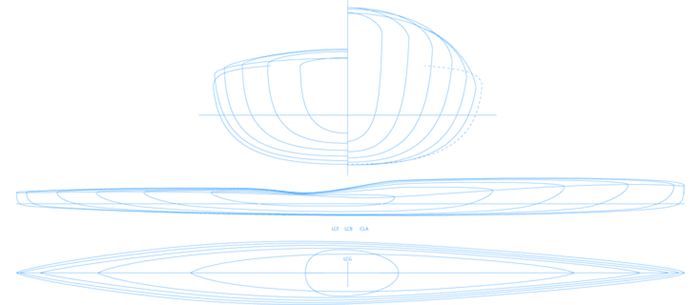
| Längd¹ |
560/552 cm (total/kvl) |
| Bredd |
52/49 cm (total/kvl) |
| Djupgående |
10 cm |
| Sittbrunn¹ |
78x39 cm |
| Innerhöjd¹ |
28,5/18 cm (framför/bakom sittbrunnen) |
| Vikt² |
16-19 kg |
| Deplacement/volym⁶ |
120 kg/375 liter |
| Prismatisk koefficient |
0,563 |
| Våt yta |
2,07 m² |
| Stabilitet⁵ |
3/4 (initial/slutstyvhet) |
| Användningsområde |
Långfärd, surf, tävling i hav eller sjösystem |
| Längd¹ |
560/552 cm (total/kvl) |
| Bredd |
53/50 cm (total/kvl) |
| Djupgående |
11 cm |
| Sittbrunn¹ |
80x40 cm |
| Innerhöjd¹ |
31/20 cm (framför/bakom sittbrunnen) |
| Vikt² |
17-20 kg |
| Deplacement/volym⁶ |
135 kg/395 liter |
| Prismatisk koefficient |
0,563 |
| Våt yta |
2,12 m² |
| Stabilitet⁵ |
3/4 (initial/slutstyvhet) |
| Användningsområde |
Långfärd, surf, tävling i hav eller sjösystem |
¹ Dessa mått kan lätt ändras efter egna önskemål
² Beroende på träslag, utrustning, noggrannhet med slipning, laminering etc.
³ Marschfart resp. motsvarande toppfart. Värdena är från början teoretiskt uträknade (Crouch´s formel) och justerade efterhand som jag kan göra relevanta praktiska tester.
⁴ Släpmotståndet i 4 resp. 5 knop mätt i kp vid angiven lastkapacitet.
⁵ Initialstabilitet resp. slutstabilitet – 1 är mycket rank, 5 är mycket stabil.
⁶ Deplacement är kajak + paddlare + last. Räkna bort kajakens vikt för att få lastkapaciteten.
Om ritningar och bygge
Ritningsbladen rymmer den information som behövs för att bygga kanoten. Spant, stävar och eventuella konstruktionsdetaljer i fullskala. Linje- och konstruktionsritning i skala 1:10. Viktiga detaljer eller idéskisser i full skala. För kajaker finns sittbrunnsförslag plus anvisningar för att ändra. På ritningen finns även anvisningar för att bygga kajaken kortare eller längre.
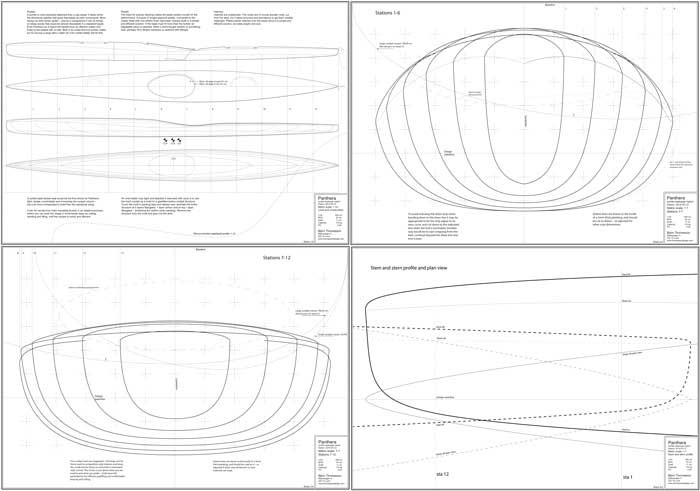
 Med ritningssatsen följer en illustrerad byggmanual med 36 sidor, som går igenom alla moment – tillräckligt detaljerat för att även en helt ovan byggare skall klara av att bygga kajaken.
Med ritningssatsen följer en illustrerad byggmanual med 36 sidor, som går igenom alla moment – tillräckligt detaljerat för att även en helt ovan byggare skall klara av att bygga kajaken.
Ritningssats, Panthera - 1 500 SEK
Beställ
Minsta fönstermått för att lyfta ut den färdiga kajaken: 53x28 cm
Bakgrund och historia
På andra sidan Atlanten har det ett tag funnits ett stort intresse för surfskis med kajakdäck. Dan Caouette har på beställning byggt en snygg Spray med kajaksittbrunn.
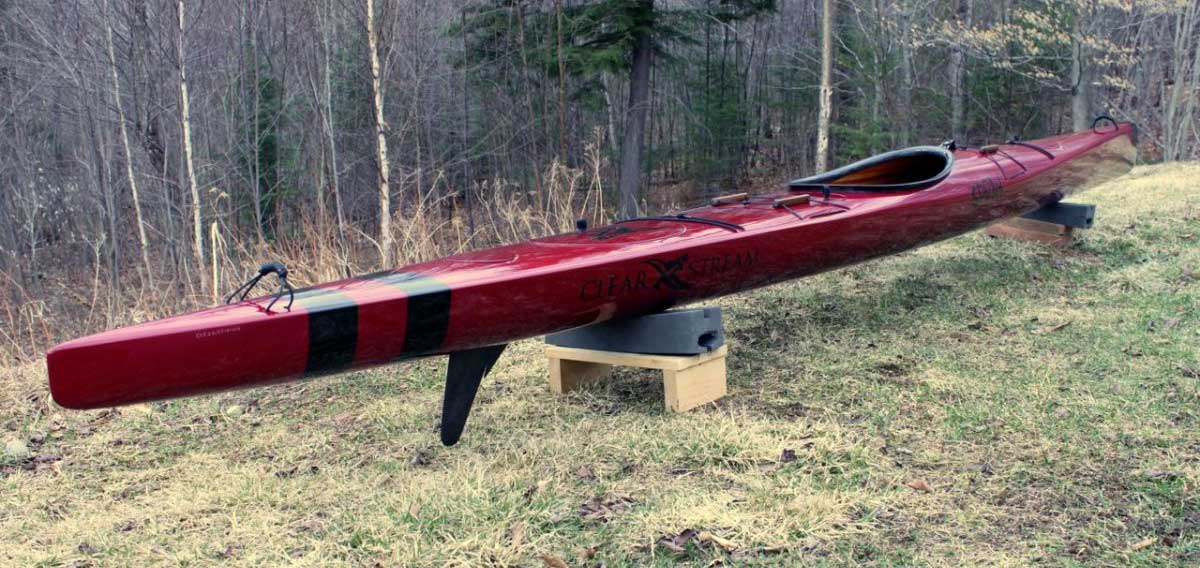
Med John Abercrombie har jag haft en lång mailkonversation om ett liknande projekt. Den fick mig att plocka fram en fjolårsidé ur mappen med mer eller mindre realistiska uppslag och hugskott: en kajak med linjer inspirerade av den snygga och spännande Jaguar CX75, en elhybrid i superbilsklassen byggd för att fira Jaguars 75-årsjubileum.
Bortsett från att bilen i sig är spännande – en elmotor för varje hjul (fyrhjulsdrift utan differential och komplicerad styrning) på totalt 778 hk, två microgasturbiner från Bladon Jets som laddar batterier och ger en räckvidd på ungefär 90 mil och som kan köras på det mesta (diesel, biobränsle, gas, bensin) och släpper ca 28 gr/km CO2 utslaget på hela sträckan – är den också en av de snyggaste designarbeten jag sett på länge. Som få andra bilar känns den designmässigt genomarbetad – inte hopsatt av många var för sig trevliga detaljer eller uppstylad med grabbiga wow-attribut som alltför många bilar både i superbilsklassen och i övrigt – utan en sammanhållen väl genomförd och mycket elegant form. Tyvärr innebar den globala ekonomikrisen att marknaden för fabulöst dyra bilar krympte, och projektet lades ner för ett par år sedan.
Men medan den fortfarande var aktuell hamnade många bilder i min bra-att-ha-mapp, varifrån jag plockade fram den och började leka på det digitala ritbordet.

Utgångspunkten för det som skulle bli Panthera år 2015, var ungefär: surfski-liknande prestanda vad gäller fart, kapacitet vid surf i vågor, suveräna manöveregenskaper med ett effektivt roder, stabilitet ungefär som Frej (John byggde en Frej för ett tag sedan), lastkapacitet och innervolym som Njord, däckshöjd för att rymma ett pedalställ (byggt eller köpt) för rodret och en jaguarliknande relingslinje där en accentuerad dip fungerar som urskärningar för paddelföringen.

Visuellt har Jaguaren fungerat som inspiration, men en kajak är så mycket enklare än en bil och saknar många av de detaljer som skapar dynamik i linjerna: hjulhus, belysning, luftintag, avgassystem, glasrutor, så egentligen är det inte så mycket mer än sidolinjen jag har kunnat arbeta in. Sedan kan man såklart hotta upp en kajak med dekaler eller spännande mönster – men ännu så länge är det ett rent designjobb. Styling får komma senare. Eller inte...
Resultatet blev att en ritning på en vid tillfället inte namngiven kajak skickades över Atlanten till John Abercrombie och efter någon månad resulterade i bilderna nedan – den första Pantheran med mycket elegant svart skrov och kopparlackat däck (diskuterad och kommenterad här på Kayak Building Forum).

Kajaken fick namnet Panthera efter det latinska namnet på Jaguar: Panthera Onca.
En Panthera under byggnad i Luxembourg
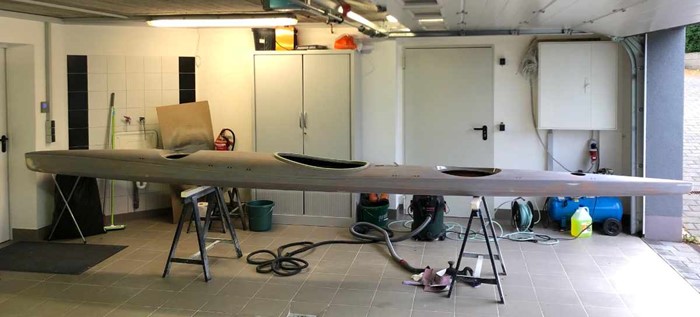
Jag passade också på att damma av en gammal skiss ur arkivet. Den skrotades för flera år sedan eftersom Point 6.5 hann före med namnet Orca. Men om någon byggare vill ta ut svängarna ordentligt med dekoren – och är villig att ta risken att någon riktig Orca fattar tycke för kajaken – så är det fritt fram att använda idén (vilken Dan Caouette gjorde nyligen: visserligen inte en Panthera men väl en liten baidarka för sin dotter).

Panthera Special
Ett par speciella Pantheraprojekt är de som sponsrades av Kanokajakcenter för långdistanstävlingar och extrempaddlingar. Båda är aningen justerade efter paddlarnas längd och vikt och byggdes av Petruskajak i Tranås:
Inför 2018, en Panthera för Fylkir Saevarson, dekorerad med isländska flaggan...

...och 2019, en Panthera för Jacob Norris, i English racing green.

(Bilden nedan är från M24KC 2019, Malmö Kanotklubbs 24-timmars kajakchallenge.
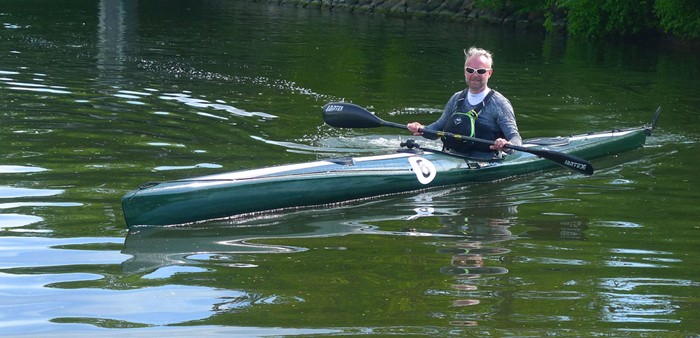
"Den nye Panthera er blevet min bedste kompis, det er muligvis Danmarks hurtigste havkajak."
En rekord-Panthera
Efter ett par år togs Saevarsons Panthera över av Erik B. Jørgensen, fick en ny grafisk profil med de danska färgerna, varefter Erik satte ett nytt imponerande rekord: Danmark runt på 14 dagar! Det gamla rekordet löd på 18 dagar.
Mitt förslag till färg och grafik:

...och en bild från rekordpaddlingen (Foto: Claus Lillevang)
...och en liten sekvens ur ett danskt TV-program där Erik tävlar mot en tremastad skonare att komma först runt en liten ö (hoppa till 10:33 för att slippa alltför mycket TV-trams). I svag vind var Erik den självklara vinnaren och behållningen av "kampen" var främst de korta momenten med Eriks effektiva paddelteknik och den välbyggda Pantheran som gled snabbt genom vattnet med väldigt lite svall.
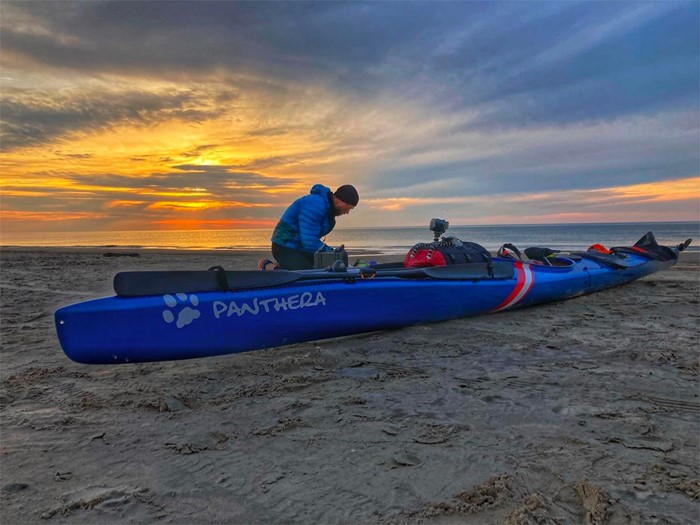
Se Kommentar 67 nedan för mer info (Tack Jenny!).
Och här är Eriks egen berättelse.
